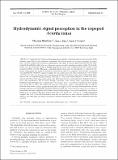Por favor, use este identificador para citar o enlazar a este item:
http://hdl.handle.net/10261/184194COMPARTIR / EXPORTAR:
 SHARE SHARE
 CORE
BASE CORE
BASE
|
|
| Visualizar otros formatos: MARC | Dublin Core | RDF | ORE | MODS | METS | DIDL | DATACITE | |

| Título: | Hydrodynamic signal perception in the copepod Acartia tonsa |
Autor: | Kiørboe, Thomas CSIC ORCID; Saiz, Enric CSIC ORCID ; Visser, André | Palabras clave: | Turbulence Predator detection Threshold deformation rate |
Fecha de publicación: | abr-1999 | Editor: | Inter Research | Citación: | Marine Ecology Progress Series 179: 97-111 (1999) | Resumen: | Copepods may remotely detect predators from the velocity gradients these generate in the ambient water. Each of the different components and characteristics of a velocity gradient (acceleration, vorticity, longitudinal and shear deformation) can cause a velocity difference between the copepod and the ambient water and may, therefore, be perceived by mechanoreceptory setae. We hypothesised that the threshold value for escape response to a particular component depends solely on the magnitude of the velocity difference (- signal strength) it generates. In experiments we isolated the different components and noted the minimum intensities to which the copepod Acartia tonsa responded. As hypothesised, threshold signal strengths due to longitudinal and shear deformation were similar, ~0.015 cm s-1, and were invariant with developmental stage. The latter implies that the threshold deformation rate for response scales inversely with size, i.e. that large stages respond to lower fluid deformation rates than small stages and, hence, may detect predators at longer distances. Signals due to vorticity and acceleration did not elicit escape responses, even though their magnitude exceeded threshold signal strength due to deformation. We suggest that A. tonsa cannot distinguish such signals from those due to their own behaviour (sinking, swimming, passive reorientation due to gravity) because they cause a similar spatial distributions of the signal across the body. Reinterpretation of data from the literature revealed that threshold signal strength due to deformation varies by ca 2 orders of magnitude between copepods and exceeds the neurophysiological response threshold by more than a factor of 10. In contrast, threshold deformation rates vary much less, ~0.5 to 5 s-1. Model calculations suggest that such threshold deformation rates are just sufficient to allow efficient predator detection while at the same time just below maximum turbulent deformation rates, thus preventing inordinate escapes | Descripción: | 15 pages, 9 figures, 6 tables | Versión del editor: | https://doi.org/10.3354/meps179097 | URI: | http://hdl.handle.net/10261/184194 | DOI: | 10.3354/meps179097 | Identificadores: | doi: 10.3354/meps179097 issn: 0171-8630 e-issn: 1616-1599 |
| Aparece en las colecciones: | (ICM) Artículos |
Ficheros en este ítem:
| Fichero | Descripción | Tamaño | Formato | |
|---|---|---|---|---|
| Kiorboe_et_al_1999.pdf | 1,49 MB | Adobe PDF |  Visualizar/Abrir |
CORE Recommender
SCOPUSTM
Citations
174
checked on 20-abr-2024
WEB OF SCIENCETM
Citations
164
checked on 27-feb-2024
Page view(s)
168
checked on 24-abr-2024
Download(s)
164
checked on 24-abr-2024
Google ScholarTM
Check
Altmetric
Altmetric
NOTA: Los ítems de Digital.CSIC están protegidos por copyright, con todos los derechos reservados, a menos que se indique lo contrario.
